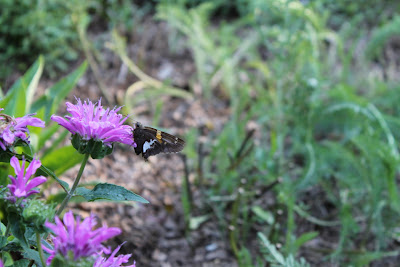It's been a while since I documented the progress in our vegetable garden -- and there has been plenty of progress, indeed. The last time I posted a full picture of the garden was on April 22, when we had just set out the first lonely lettuces, and most of the other beds were made, but still virgin.
 |
| Garden in a state of readiness |
Now, two months later, all that preparation has yielded to bounty, and today the garden looks like this:
 |
| Garden in a state of bounty |
Vegetables require more faith than flowers, I think. Perennial flowering plants are independent self-starters once you get them in a spot they like, providing color and excitement with little encouragement as soon as the snow melts. But veggies require foresight, planning, constant vigilance, and a cooperative climate. And even then things can go horribly wrong. More than once we've had a great crop of beans decimated overnight by the lone deer who managed to breach our defenses. And two years ago an awful tomato blight visited all the plants in our area; we managed to salvage most of our crop by judicious pruning and some chemical assistance (shhh... for tomatoes, it's worth it).
So preparing the vegetable garden each spring for another growing season is truly an act of faith. And at this point in the season, it appears ours is being rewarded. Some of the crops we've had trouble with in the past are having a banner year. I wish I knew why and could bottle it, but I'm happy to simply eat the benefits. I'm particularly delighted with the kohlrabi, which last year was prevented from reaching maturity by a vicious band of cutworms -- nasty little buggers that chomp through the infant stems of many plants in the brassica family, which includes kohlrabi, broccoli, brussels sprouts, and cabbages. In short, all the stuff kids won't eat.
But I love kohlrabi. As much for the way they look as the way they taste. They look like miniature sputniks from the early space age. Round globes with antennae-like stems which could just as easily be receiving signals from outer space. (Or perhaps serving as the internet connection for reporters from the Insect Informer?!)
 |
| Kohlrabi ready for harvest |
If you find these in the store, they tend to be tough softball sized lumps which defy preparation. When picked at hardball size however, they have a delicate flavor, halfway between peas and asparagus. They have many applications. I've use them peeled and raw, grated fine with carrots in a variation on cole slaw, sliced and blanched, and then sauteed in butter by themselves, or julienned, blanched, and sauteed mixed with sugar snaps. That's this year's kitchen trend.
 |
| Kohlrabi and Sugar Snap peas getting acquainted |
 |
| All blanched and ready for sauteeing |
Speaking of peas, I owe Mr. Mulch an apology for maligning his pea harvest a few posts ago. I was worried that the early heat would lead to a legume-shortage, but that worry was totally unfounded. The hot weather did slow them down, but once they got started, they have been very prolific. We have more than enough to gorge on, and still have plenty to blanche and freeze so we can have a taste of spring deep into next winter.
 |
| No pea shortage after all |
Here are some of the other veggies that have rewarded our faith so far this season:
Garlic scapes in abundance, twisting in fanciful curlicues above the cloves. I use these instead of garlic in sautees, and also to make a wonderful garlic scape bean dip (process 5-6 scapes with some lemon juice, salt, olive oil, and a drained can of white beans -- instant garlic scape hummus!). Recently we went to a dinner party where the hostess took advantage of their natural curl to use them as wrap-around napkin holders! They inspire creativity.
 |
| Garlic scapes dancing above their cloves |
Cucumbers are flowering and sporting teeny fruit. We should have cukes to eat in another week or so.
 |
| Portent of cukes to come |
Tomatoes are fruiting, growing, and looking healthy. I probably shouldn't jinx them, but... no sign of voracious tomato hornworms here so far. (Shhhh...)
 |
| Green tomatoes |
We've been cutting and eating chard for several weeks. It's a very obliging plant, and continues to grow back for more cutting and eating. Here it is, ready for another round.
 |
| Chard ready for the next meal |
The eggplant seem to have recovered from the earlier bug attack and are starting to produce -- very small at the moment, but not for long.
 |
An eggplant puppy!
|
And finally, we have our first squash. No matter how much room we give them in the bed, they prefer to grow outside. I guess they like their freedom!
 |
| Yellow squash trying to escape |
It's at this point in the growing season when we figure out what to have for dinner by going for a stroll in the garden. As we survey the options, and see that our faith has been rewarded, we feel truly blessed by the bounty of nature (with many thanks to Mr. Mulch).
















































